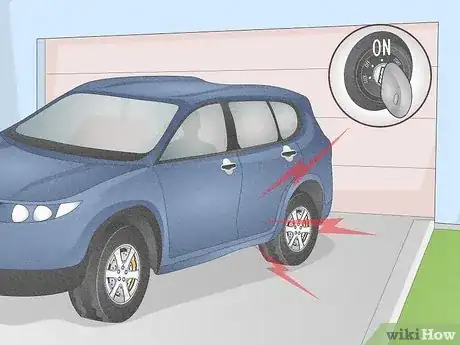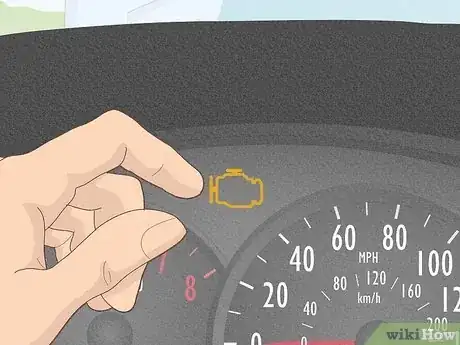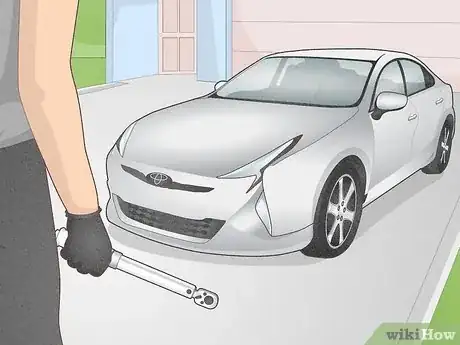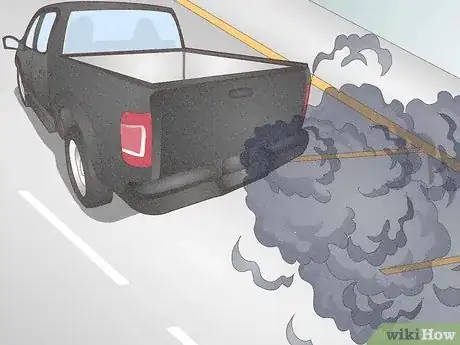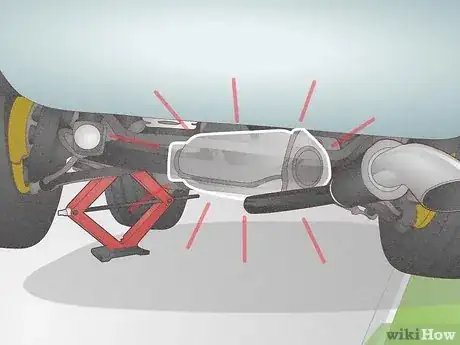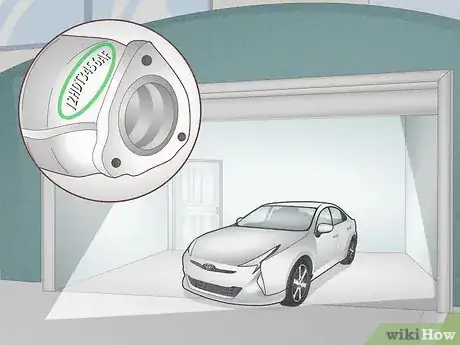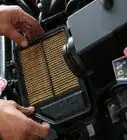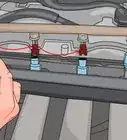This article was co-authored by wikiHow staff writer, Christopher M. Osborne, PhD. Christopher Osborne has been a wikiHow Content Creator since 2015. He is also a historian who holds a PhD from The University of Notre Dame and has taught at universities in and around Pittsburgh, PA. His scholarly publications and presentations focus on his research interests in early American history, but Chris also enjoys the challenges and rewards of writing wikiHow articles on a wide range of subjects.
This article has been viewed 79,220 times.
Learn more...
A catalytic converter reduces harmful emissions from your vehicle, but it also contains precious metals that make it an enticing target for thieves. A stolen catalytic converter isn’t obvious at first glance, so we’ve listed all the key signs of theft you should watch out for. We’ve also added tips on what to do in this scenario, and what to do to prevent it in the first place.
Things You Should Know
- Signs of catalytic converter theft include a roaring engine, smokier and smellier exhaust, poor engine performance, and an engine warning light.
- If your catalytic converter has been stolen, drive only if necessary and call the police, your insurance company, and a repair shop.
- Reduce your chances of theft by parking in a safe location, marking your catalytic converter, and installing an anti-theft device.
Steps
Your vehicle sounds really loud when you start it up.
-
The loud noise will likely be your first sign of a problem. Everything will probably look fine with your vehicle, but when you turn the key you’ll hear an unfamiliar and unwelcome roar. While other problems—like a muffler that needs replaced—may be the culprit, now’s the time to suspect that your catalytic converter has been stolen.[1] X Research source
- You might hope that really loud engine sound will go away if you rev the engine a little or try to drive off. But, the reality is that the roaring sound will get even louder and obvious when you press down on that pedal.
An engine warning light shows up on your dashboard.
-
A missing catalytic converter will trigger oxygen sensors in your exhaust. It probably won’t take long for that dreaded engine warning light to appear. When it does, you can use an OBD code scanner to identify the specific problem, or you can just go ahead and make a service appointment for your vehicle.[2] X Research source
- No matter the cause, don’t ignore that “check engine” light!
You have a vehicle that’s a high-value target for thieves.
-
Pickups, SUVs, and hybrids are common targets. Catalytic converter theft is usually a crime of opportunity, and vehicles that are higher off the ground make it easier to quickly access the desired part. That said, hybrid cars—most notably the Toyota Prius—are very common targets for a completely different reason: their catalytic converters have more of the precious metals that thieves are after.[3] X Research source
- Does this mean your car definitely won’t be targeted if it’s not one of these vehicles? Unfortunately not. But it pays to take extra precautions if you have a high-value target vehicle.
- Catalytic converters have been required on all automobiles sold in the U.S. since 1974, so pretty much any vehicle on the road today can be a target!
You smell noxious exhaust seeping into your vehicle.
-
Get out of the car if you smell exhaust, since it can be deadly. Without a catalytic converter, your vehicle spews out a lot of nasty stuff, including potentially-deadly carbon monoxide. The exhaust will smell more potent than usual and is likely to seep up into the cabin from underneath your car. If you smell this exhaust odor, it’s time to shut off the car and get out.[4] X Research source
- If you develop symptoms like shortness of breath, dizziness, or nausea, get into fresh air and seek medical help for carbon monoxide poisoning.
The vehicle is creating a cloud of bluish, smoky exhaust.
-
The exhaust won’t just smell worse—it’ll look thicker and dirtier, too. The exhaust from a modern vehicle is usually nearly invisible. Without the catalytic converter doing its thing, however, the exhaust coming from your vehicle will appear much thicker and darker, likely with a gray-blue tint to it. You’ll feel like you’ve stepped back in time to when cars belched out smelly, sooty exhaust.[5] X Research source
- Modern vehicles still spew out exhaust that contains lots of things that are bad for your health and for the environment. But the difference a catalytic converter makes will be clear to see (and smell).
You can see damage or missing parts under your vehicle.
-
Crouch down and take a look to confirm your suspicions. Look particularly in the area in front of the muffler. If the catalytic converter is gone, you’ll see an empty space and exposed sections of the exhaust line. Thieves usually steal catalytic converters by cutting them out, so you’ll see saw marks and probably other damage along the exhaust line.[6] X Research source
- The catalytic converter is just a small cylindrical canister that can be hard to spot when it’s installed properly. But it’ll be pretty clear that something’s missing when you take a closer look.
The vehicle is sluggish or sputters if you try to drive it.
-
It’s best not to drive the vehicle, but you’ll notice the difference if you do. Modern vehicles are designed to have functional, clean catalytic converters, so you can cause substantial damage by driving without one. Among other problems, your vehicle’s computer won’t be able to calculate the proper fuel injection rate, leading to obvious sluggishness and sputtering of the engine if you attempt to drive.[7] X Research source
What to do if your catalytic converter is stolen:
-
Call the police, arrange for repairs, and try not to drive the vehicle. You’ll be angry, confused, and maybe a bit fearful once you figure out your catalytic converter has been stolen. Focus on simple measures you can take to handle the situation:[8] X Research source
- Call for roadside assistance. Instead of trying to drive your damaged vehicle home or to a garage, have it towed to a repair shop to assess the situation.
- Call your car insurance company. A stolen catalytic converter should be covered (minus any deductible) if you have comprehensive (not just collision) coverage.
- File a police report. While the chances of recovering your catalytic converter aren’t great, definitely let the police know about the theft. (Call the police first if you’re stranded away from home and don’t feel safe.)
- Inform local scrap yards and metal recyclers. They may be willing to let you know if any suspicious catalytic converters show up at their businesses. The odds of getting their help are much better if you add identifying markings to your catalytic converter (see the next step).
What to do to prevent catalytic converter theft:
-
Make your catalytic converter harder to access and easier to identify. A stolen catalytic converter can cost up to $3,000 USD to replace, so it definitely pays to take theft prevention measures like the following:[9] X Research source
- Park in a well-lit area with cameras, or in a locked garage. Thieves target vehicles that are easy to access without being seen. The less enticing of a target you make your vehicle, the less likely you are to be victimized.
- Have your VIN etched onto your catalytic converter. Having the vehicle identification number (VIN) on the catalytic converter makes it possible to track down the part if it is stolen. Its mere presence on the part may also stop a thief from taking it in the first place. Ask an auto repair shop about this service.
- Spray paint your catalytic converter a bright color. Do this on its own, or combine it with VIN etching. Reputable scrap metal dealers are less likely to accept painted catalytic converters because of the likelihood that they’re stolen.
- Get your vehicle alarm’s sensitivity level adjusted. A trained vehicle mechanic can adjust the sensitivity of your alarm so that it will go if someone starts bumping around underneath it. But you’ll also end up with more false alarms!
- Have an anti-theft device installed over your catalytic converter. Some repair garages will install cages, shields, cables, or other protective devices for under $1,000 USD. Anything that makes it harder to remove the part is likely to deter thieves.
You Might Also Like
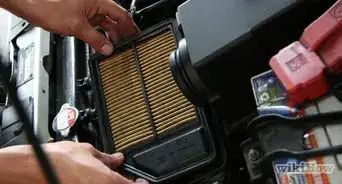 Step-by-Step Methods for Adjusting a Carburetor
Step-by-Step Methods for Adjusting a Carburetor
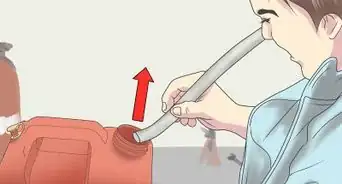


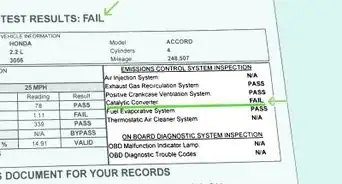 9 Signs That Your Catalytic Converter is Going Bad
9 Signs That Your Catalytic Converter is Going Bad

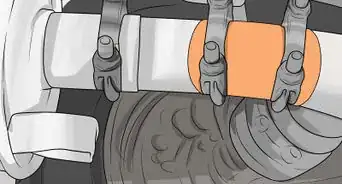



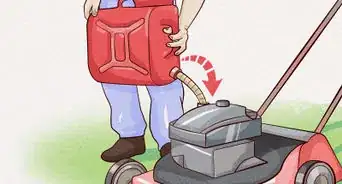
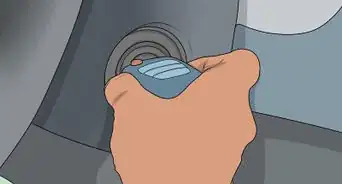

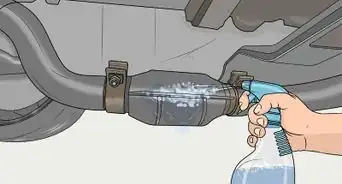
References
- ↑ https://driving.ca/column/corner-wrench/your-corner-wrench-what-if-someone-swipes-your-catalytic-converter
- ↑ https://www.kxxv.com/news/local-news/catalytic-converter-thefts-are-on-the-rise-heres-what-to-do-if-you-become-a-victim
- ↑ https://www.nerdwallet.com/article/loans/auto-loans/5-ways-to-foil-catalytic-converter-thieves
- ↑ https://www.kxxv.com/news/local-news/catalytic-converter-thefts-are-on-the-rise-heres-what-to-do-if-you-become-a-victim
- ↑ https://www.kxxv.com/news/local-news/catalytic-converter-thefts-are-on-the-rise-heres-what-to-do-if-you-become-a-victim
- ↑ https://www.kxxv.com/news/local-news/catalytic-converter-thefts-are-on-the-rise-heres-what-to-do-if-you-become-a-victim
- ↑ https://driving.ca/column/corner-wrench/your-corner-wrench-what-if-someone-swipes-your-catalytic-converter
- ↑ https://www.nerdwallet.com/article/loans/auto-loans/5-ways-to-foil-catalytic-converter-thieves
- ↑ https://www.nerdwallet.com/article/loans/auto-loans/5-ways-to-foil-catalytic-converter-thieves
About This Article

